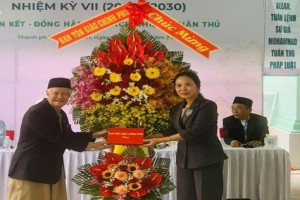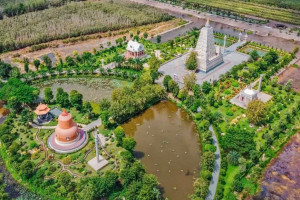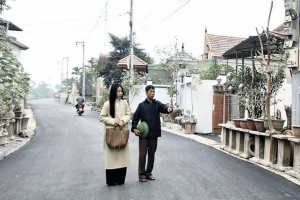
Buddhism has been introduced and developed in many countries in the world. Anywhere Buddhism has been present, its society, people, custom and culture are influenced by humane spirit of Buddhism. At the same time Buddhism also adjusts itself in accordance with condition of each country.
For that reason, Buddhism not only keeps its values but also harmonizes with cultural diversity of each nation. When Buddhism entered Vietnam, it was accepted, vietnamized by Vietnamese people. It turned into Vietnamese Buddhism. Almost Vietnamese people consider Buddhism as their religion, the religion of their ancestors and nation. So it is called Vietnamese Buddhism.

Buddhism has existed and developed in Vietnam for nearly 2000 years. It has experienced ups and downs of national history but it affirms its role in the nation. Buddhism confirmed its position in the nation. In any period, Vietnamese Buddhism has worthy contributions to the country. In the days of building independent feudal state, a lot of bonzes were excellent cultural personalities, politicians, diplomats such as Ngo Chan Luu in the Dinh Dynasty, Van Hanh, Da Bao, Sung Pham in the Ly Dynasty, King Tran Nhan Tong in the Tran Dynasty, superior Buddhist monk Thich Quang Duc, Thien Chieu in Ho Chi Minh era. They played important roles in building and defending our country.
In the two resistance wars against French colonialists and American imperialist, many monks became soldiers, they “replaced frocks with military coats ”. They left their temples to join in national army, typically Monk Thich The Long (Nam Dinh), Monk Huu Nhem (Ca Mau). Many temples became the shelters for revolutionaries. Many Buddhist monks, believers became key forces in resistance organizations such as Buddhist national Salvation associationof Mahayana Buddhism, the South Western patriotic clergy solidarity association of Theravada Buddhism. Vietnam Buddhism has a part in creating glorious page in our history.
When peace was restored in our country. All of Vietnamese people tried to heal all sorrows of the war and build the country towards socialism. Vietnamese Buddhism has contributed to building Vietnam country “for better secular and religious life”
In Vietnam there are two Buddhist branches: Theravada Buddhism (the Way of the Elders) and Mahayana Buddhism(the Great way). Theravada Buddhism was propagated in India, Sri Lanka, Myanmar, Thailand, Lao, Cambodia and Vietnam. It was called “Southern Buddhism”. This school advocated Buddha teachings when he was alive ( it original spirit of Buddhism). Mahayana Buddhism started from India then it was propagated in China, Vietnam, North Korea and Japan. It was named “Northern Buddhism”. This school wanted application of the rules of the discipline free. This school thought that, the only goal worthy of attainment was Buddha hood..

Vietnam Buddhism has all the characters of the general Buddhism. Yet when entering Vietnam, Buddhism has integrated, accommodated with Vietnamese spiritual life and culture. Because of special characteristics, Vietnamese Buddhism has become flexible and plentiful. Some special characteristics of Vietnamese Buddhism as follows:
1.Buddhism has integrated with traditional beliefs: Vietnam Buddhism has integrated with Vietnamese traditional beliefs such as worship of ancestor, Gods, and Holy Mother but it has still remains its key role to build up Vietnam Buddhism. This problem has been showed clearly in arranging worshipping statues in Main hall in Buddhism temples. Buddha is in the middle room, the statues of founders of Taoism and Confucianism are in next rooms. In the temples there many statues: the statues of Jade Emperor and the statues of Ten Kings of hell , the statue of Jade Emperor. In temple precincts, especially the temples in the North there are altar of Mother Goddesses and altar of saint ( Tran Hung dao). Some temples there are altars of patriarchs
2. Buddhism is a religion of three religions in the same origin. Vietnamese Buddhism combines with Confucian and Taoist spirits to become “three religions in the same origin” to defend the country. This is intelligent combination. In the first days of building independent feudal regime, many famous Buddhism monks understood Confucianism, Taoism and applied three religions in their meditation life. They practiced Buddhist law, took part in political affairs. After fulfilling their duty, they came back to the forest and lived in seclusion. This is an unusual feature in the world.
3. Buddhism has a strongattachment to nation: After coming to Vietnam, Buddhism became religion of Vietnam. Vietnamese Buddhism has patriotic tradition and it always goes together with nation, Vietnam Buddhism has contributed to struggles against foreign enemies. Vietnam Buddhism has recognized two special persons. First, Monk Ly Cong Uan returned to the secular life and became a king. He founded the Ly dynasty. Second, King Tran Nhan Tong who left his throne, lived in a mountain and became the founder of Buddhist school in the Tran dynasty. In period of integration , Buddhism always shares difficulties and supports the people who are in the difficult conditions. Vietnamese Buddhism also contributed to stabilization of society, reduction of poverty and development of economy.
4. Buddhism is an internal unity: Vietnam Buddhism has a spirit of internal unity. Although Vietnam Buddhism has a lot of schools, all of them have coexisted and developed. They have the same organization such as Vietnam Buddhist Sangha. In 1981, 9 Buddhist schools from across the nation unanimously agreed to establish the Vietnam Buddhist Sangha. Its charter affirms that Vietnam Buddhist Sangha is the sole organization representing Buddhist monks, nuns and believers at home and abroad. Buddhism also unites all the social classes and other religions in building and developing our country. We can not find this problem in Buddhist organizations in other countries.
5. Vietnamese Buddhism has sectarian characteristics:After entering Vietnam, Buddhism has formed and developed according to the tradition of inhabitants. Management of monks is carried out by each sect. Buddhist Sangha only makes plan for great Buddhist affairs. Other activities such as , teaching dogmas and religious ceremonies … are undertaken by the leader of sect.
6. Buddhism is a component of culture: Buddhist culture and morality root deeply idea of Vietnamese people. They contribute to establishment of Vietnamese culture deeply imbued with national identity.

In the context of modern society, Buddhist monks and nuns have not only relation with teachers and students, friend but also other social relations. The large relations influence the tradition of Vietnamese Buddhism What a pity!, few monks, nuns and Buddhists are interested in normal needs so they forget great values in Buddha teaching. But they can not changes the nature and long tradition of Vietnamese Buddhism.
With those characters, Vietnam Buddhism has been playing an important role in social life. Vietnamese Buddhism will exist in the heart of Vietnamese nation forever..
Yên Sơn




